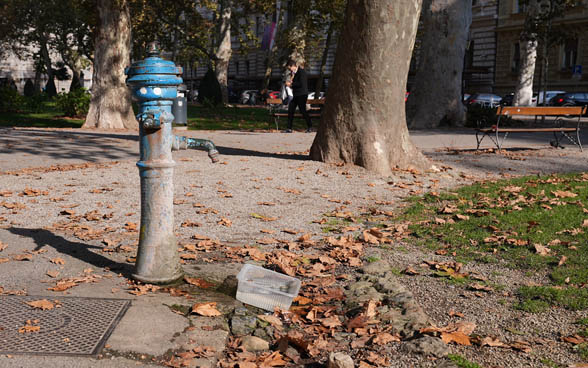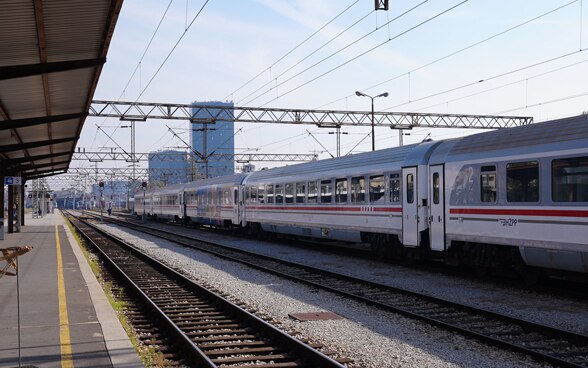Supporting research on homelessness in Croatia and Switzerland
The SDC is financing a project that conducts research on homelessness in Switzerland and Croatia – a success story.

Lynette Šikić-Mićanović during a visit to the Swiss embassy in Zagreb. © SDC
When Lynette Šikić-Mićanović walks through the streets of Zagreb she sees things that most people wouldn't notice. "For instance, in parks I keep an eye out for water sources," she says. "Public water sources and publicly accessible toilets are important for persons without permanent housing because they can wash up there."

Šikić-Mićanović is an anthropologist who teaches at the Institute of Social Sciences Ivo Pilar in Zagreb. Her field of research is homelessness. The work is painstaking and time-consuming. "We try to stay in touch with the participants of the study for the entire duration of the research project and also beyond. But these are people on the margins of society who often suffer from extreme poverty, stigma or mental health issues." Usually, she communicates with them by mobile phone, but sometimes contact to an individual is lost and then she and her team have to search for them. "Persons experiencing homelessness (PEH) are forced to constantly be on the move. This makes their lives extremely arduous."
Zagreb and Split preferable to Paris
Professor Matthias Drilling also conducts research into the same topic. He heads the Institute of Social Planning at the University of Applied Sciences and Arts Northwestern Switzerland (FHNW), Muttenz, in the canton of Basel. "It struck me a few years ago that there is a relatively large body of research on poverty in Switzerland but practically nothing on homelessness," he says.
What prompted him to examine the issue from a more professional perspective at his institute was that public discourse on the issue always revolved around the same stereotypes of substance abuse and addiction. He was in the process of identifying partner countries and funding to set up a collaborative research project when he chanced upon the Croatian-Swiss Research Programme (CSRP), which Switzerland had invited proposals for as part of the Swiss contribution to the enlarged EU.
CSRP
The duration of the Croatian-Swiss Research Programme was from 2017 to 2023, and it concluded on 31 December 2023. Switzerland co-financed 11 projects amounting to CHF 4 million. The objective of the project was to strengthen cooperation between Switzerland and Croatia in the area of scientific research, and it was implemented by the Swiss National Science Foundation (SNF) and the Croatian Science Foundation (HRZZ).
"I was aware that collaborating with Croatia would put us under pressure initially," says Drilling, considering that more research on homelessness already existed in Croatia. Even prior to the project, high-quality data and publications on the subject had been brought out in Croatia. "But this also allowed the Croatian team to assume a kind of mentoring role, which I had envisaged for us," he said. Moreover, collaboration with Croatia made sense from a research perspective because Croatian cities were comparable with those in Switzerland in terms of size. "Zagreb and Split can be much better compared with Basel and Bern than Paris, for example," says Drilling.
Excellent collaboration
Šikić-Mićanović says that she and her team too have benefited from the collaboration with Switzerland. She especially highlights the cooperation with the SNF, which was excellent in every respect. "We had planned some major projects but these partly did not materialise because of COVID-19 and the earthquake in Zagreb on 22 March 2020. As a result, we were unable to utilise project funds that had already been earmarked. However, the SNF allowed us to extend the projects and we were able to use the entire budget for our research."
Cooperation with Switzerland was very close, she says. "We sent countless emails back and forth and, of course, we also met in person on multiple occasions. During the COVID-19 crisis and after the earthquake we had to switch to digital channels, such as Skype or Zoom, but despite that we remained in close contact." The collaboration will continue even after the phasing out of the CSRP. The teams have already jointly applied for new funding. A film on homelessness is currently being produced in Croatia, for instance, where Drilling is involved as an expert reviewer.
The research project has led to direct outcomes even in Switzerland, says Drilling. His team authored several publications, including the First National Report on Homelessness in Switzerland (in German) and also organised the first national conference on the topic, bringing together over 300 participants, including academics and practitioners. Here too, the COVID-19 pandemic cast its shadow, but it also created learning opportunities for students at the FHNW. "During the pandemic, we wrote to organisations in the region asking if they needed help. In the soup kitchen 'Gassenküche Basel', for example, many of the staff had to withdraw because they were simply too old and feared for their health. We were able to support the organisations with a team of about 30 students and assist them in sustaining their infrastructure for the homeless." It proved to be a very enriching experience for the students during the gloom of the pandemic.
Some protection in railway carriages
Back to Zagreb. Something else that draws the attention of Šikić-Mićanović and her team are train carriages parked at station sidings. At the central railway station, she points beyond a platform to a row of parked carriages. Without the platform to help in boarding they appear enormous. "When it is cold the carriages offer a refuge," she says. She knows two women who regularly clamber into the carriages for some warmth and protection against the elements. Inside it is dry and reasonably safe, but one should know the exact train departure times! "If you aren't careful you could wake up in another city."

For Šikić-Mićanović it is especially important to create greater understanding for persons experiencing different kinds of homelessness. "When it comes to homelessness, many people tend to blame the victims. There are strong prevailing stereotypes and people are not aware of the structures that push individuals into this situation."Her research has shown that homelessness is a complex issue, with no single factor being the cause. "It is very easy to slip into homelessness but very difficult to escape it. The results of our research show that it could happen to anyone."
More information on the research project
The teams from Croatia and Switzerland are collaborating on the project titled 'Homelessness and Pathways to Social Inclusion: A Comparative Study of Contexts and Challenges in Swiss and Croatian Cities'. Many results and conclusions of the project are available on the website homelessness.eu.
